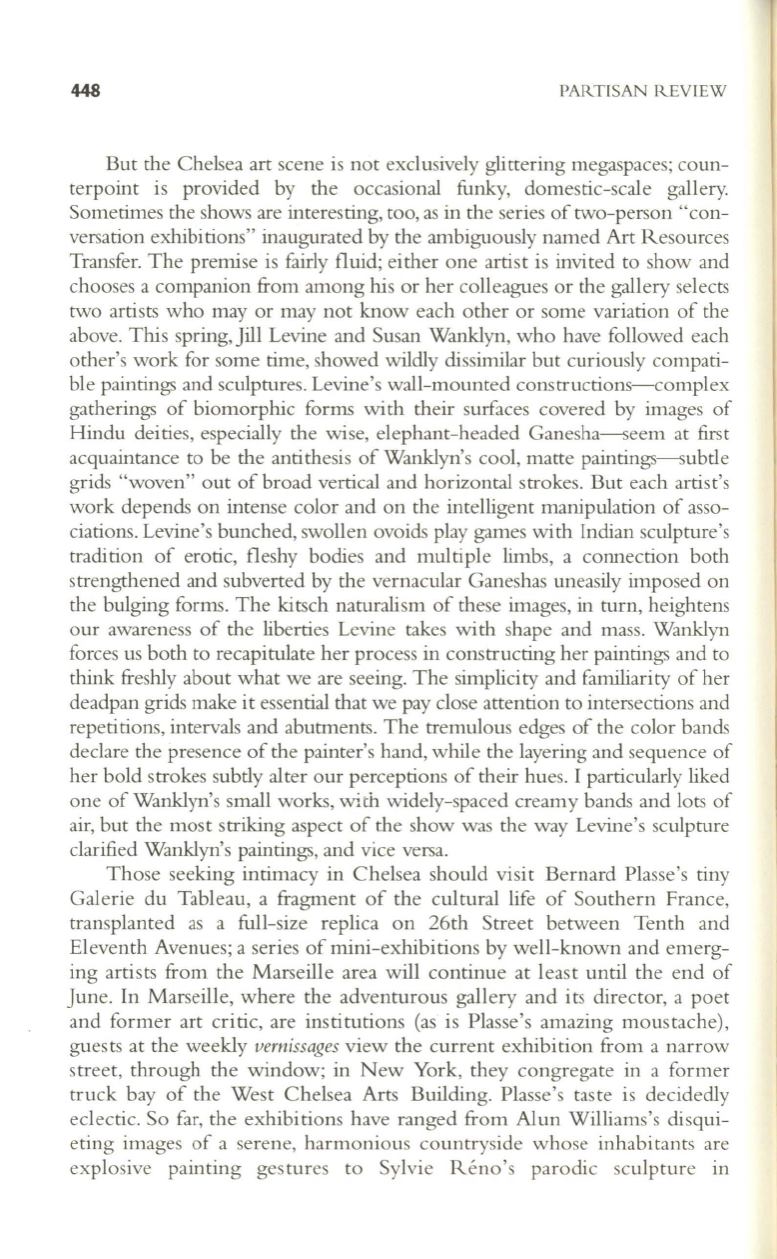
448
PAR.TISAN REVIEW
But the Chelsea art scene is not exclusively glittering megaspaces; coun–
terpoint is provided by the occasional funky, domestic-scale gallery.
Sometimes the shows are interesting, too, as in the series of two-person "con–
versation exhibitions" inaugurated by the ambiguously named Art Resources
Transfer. The premise is fairly fluid; either one artist is invited to show and
chooses a companion from among his or her colleagues or the gallery selects
two artists who mayor may not know each other or some variation of the
above. This spring, Jill Levine and Susan Wanklyn, who have followed each
other's work for some time, showed wildly dissinUlar but curiously compati–
ble paintings and sculptures. Levine's wall-mounted constructions-complex
gatherings of biomorphic forms with their surfaces covered by images of
Hindu deities, especially the wise, elephant-headed Ganesha--seem at first
acquaintance to be the antithesis of Wanklyn's cool, matte paintings--subtle
grids "woven" out of broad vertical and horizontal strokes. But each artist's
work depends on intense color and on the intelligent manipulation of asso–
ciations. Levine's bunched, swollen ovoids play games with Indian sculpture's
tradition of erotic, fleshy bodies and multiple limbs, a connection both
strengthened and subverted by the vernacular Ganeshas uneasily imposed on
the bulging forms. The kitsch naturalism of these images, in turn, heightens
our awareness of the liberties Levine takes with shape and mass. Wanklyn
forces us both to recapitulate her process in constructing her paintings and to
think freshly about what we are seeing. The sinlplicity and fanUliarity of her
deadpan grids make it essential that we pay close attention to intersections and
repetitions, intervals and abutments. The tremulous edges of the color bands
declare the presence of the painter's hand, while the layering and sequence of
her bold strokes subtly alter our perceptions of their hues. I particularly liked
one ofWanklyn's small works,
with
widely-spaced creamy bands and lots of
air, but the most striking aspect of the show was the way Levine's sculpture
clarified Wanklyn's paintings, and vice versa.
Those seeking intimacy in Chelsea should visit Bernard Plasse's tiny
Galerie du Tableau, a fragment of the cultural life of Southern France,
transplanted as a full-size replica on 26th Street between Tenth and
Eleventh Avenues; a series of mini-exhibitions by well-known and emerg–
ing artists from the Marseille area will continue at least until the end of
June. In Marseille, where the adventurous gallery and its director, a poet
and former art critic, are institutions (as is Plasse's amazing moustache),
guests at the weekly
vernissages
view the current exhibition from a narrow
street, through the window; in New York, they congregate in a former
truck bay of the West Chelsea Arts Building. Plasse's taste is decidedly
eclectic. So far, the exhibitions have ranged from Alun Williams's disqui–
eting images of a serene, harmonious countryside whose inhabitants are
explosive painting gestures to Sylvie Reno's parodic sculpture in


